Graham Potter took over the Brighton and Hove Albion job in May 2019 following his departure from Swansea City. Since then, he has led them to their highest ever Premier League points tally this season with 51. Over the last few months, Potter has been linked heavily with the Tottenham Hotspur job as well as the Manchester United job.
This tactical analysis of Graham Potter tactics will give a more clear idea as to why the 47-year-old has been taunted away from the south coast. His style of play and philosophy has led to his side becoming one of the most enjoyable teams to watch over the last few seasons. In this analysis, we will delve into the tactics behind his success with the minnows.
Graham Potter Tactics In Possession
Potter favours setting his side up in a 3-4-3 formation. This consists of unconventional wingbacks being used, most recently Leandro Trossard, who has previously played regularly as a left-sided forward. When building up, Brighton and Hove Albion stretch their back five wide to create space to receive the ball. Trossard playing left wing-back, top right of the picture below, maintains a high position to allow for him to receive the ball with time and space.
By stretching the pitch during the build-up Potter’s side are able to play around the opposition’s press with comfort and ease as there are always multiple options to pass to. By doing this in the build-up, it allows for Brighton’s two midfielders to drop deeper and receive the ball. The central midfield pairing provides a base to build upon by creating triangles with the defensive players.
Marc Cucurella at left centre-back is vital in the build-up for the Seagulls. Potter encourages his wide centre-backs to step into midfield and drive the ball forward. Cucurella’s ability on the ball allows Brighton to progress easily and in comparison to other centre backs in the Premier League, he is one of the highest accurate passers into the penalty area per 90.
The image below shows he is consistent in progressing the ball forwards throughout the season. Fellow Brighton and Hove Albion centre-backs Joël Veltman and Lewis Dunk also appear on the chart but are not quite as successful. The graph shows that the former Swansea boss sets a heavy emphasis on the left side of his pitch when building up and Cucurella is given freedom.
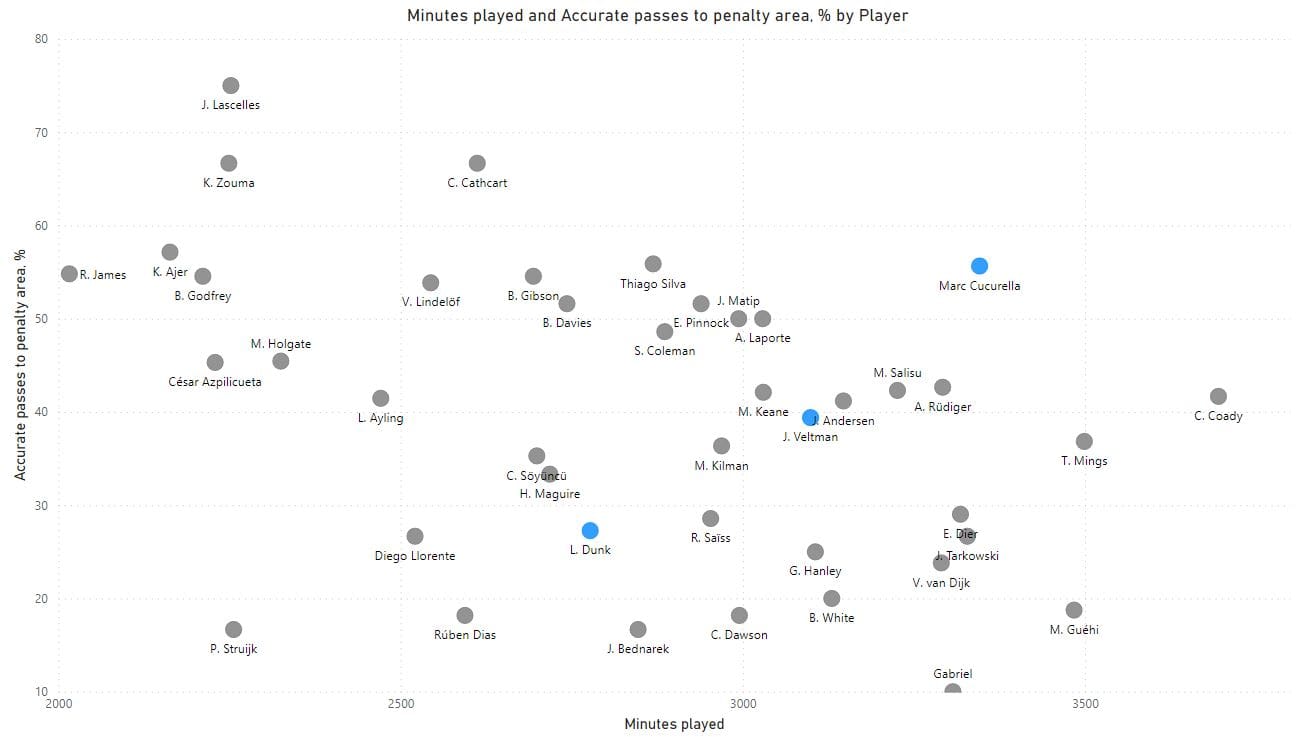
When Brighton and Hove Albion have the ball in the midfield, the team transitions into a 4-2-3-1 formation. The left-wing back pushes on and creates the attacking trio. Alexis Mac Allister drifts centrally to play in the number ’10’ position. This allows the midfield and attacking players to dominate teams in the final third by creating a solid base to build upon. There is a big emphasis on the striker moving into the space behind the opposition, something that can be seen below. The fast-paced burst through the midfield allows for Brighton to capitalise on space quickly. To do this, they must have willing runners who support the midfield.
The wingbacks of Brighton often find themselves in very advanced positions seen in the area in which an out and out winger would occupy. Below shows the left wing-back and right wingback playing on the line of the opposition defence. Ultimately, this is a risk as a quick transition could lead to the opposition counter-attacking and capitalising on the space left by the Brighton wing-backs however, Potter is willing to take this risk and nullifies it.
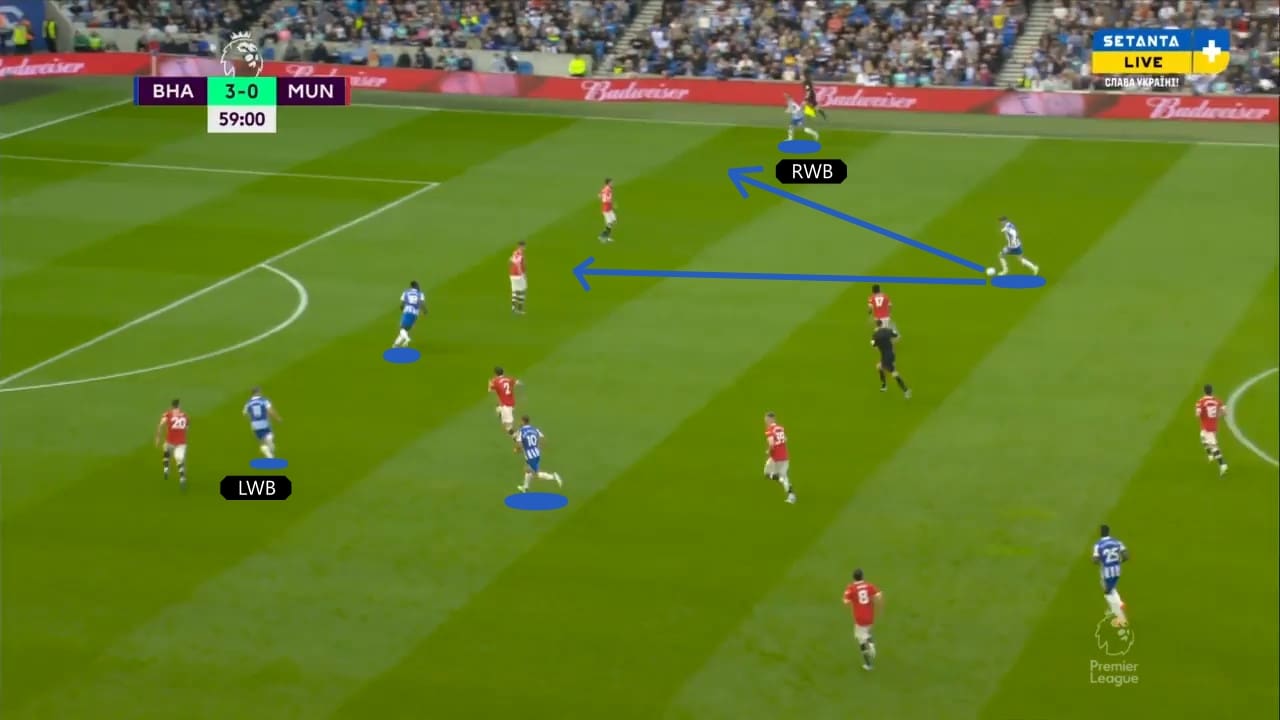
Leading on from the high involvement of wingbacks, comes the final third. The mid-table side aren’t blessed in the goalscoring department as they just scored 42 goals this season. Only four teams scored fewer than Brighton and Hove Albion this season, three of which were relegated.
As a team, Brighton like to attack the wide channels and directly get crosses into the box. Graham Potter’s men average almost 15 crosses into the box per 90, the fourth-highest in the league. The manager has set a clear way he wants his team to attack and that is to cross the ball. Brighton are good at getting bodies into the box.
The front three and opposite wingback almost always make a move into the box. The two midfielders often support this by creating a net around the edge of the box. This benefits Brighton in many ways. One is that if anything falls to the midfield in this space then a strike at goal is likely. A perfect example of this is Moisés Caicedo’s goal versus Manchester United in May. Another benefit is that it provides immediate protection from any counterattacks in transition.
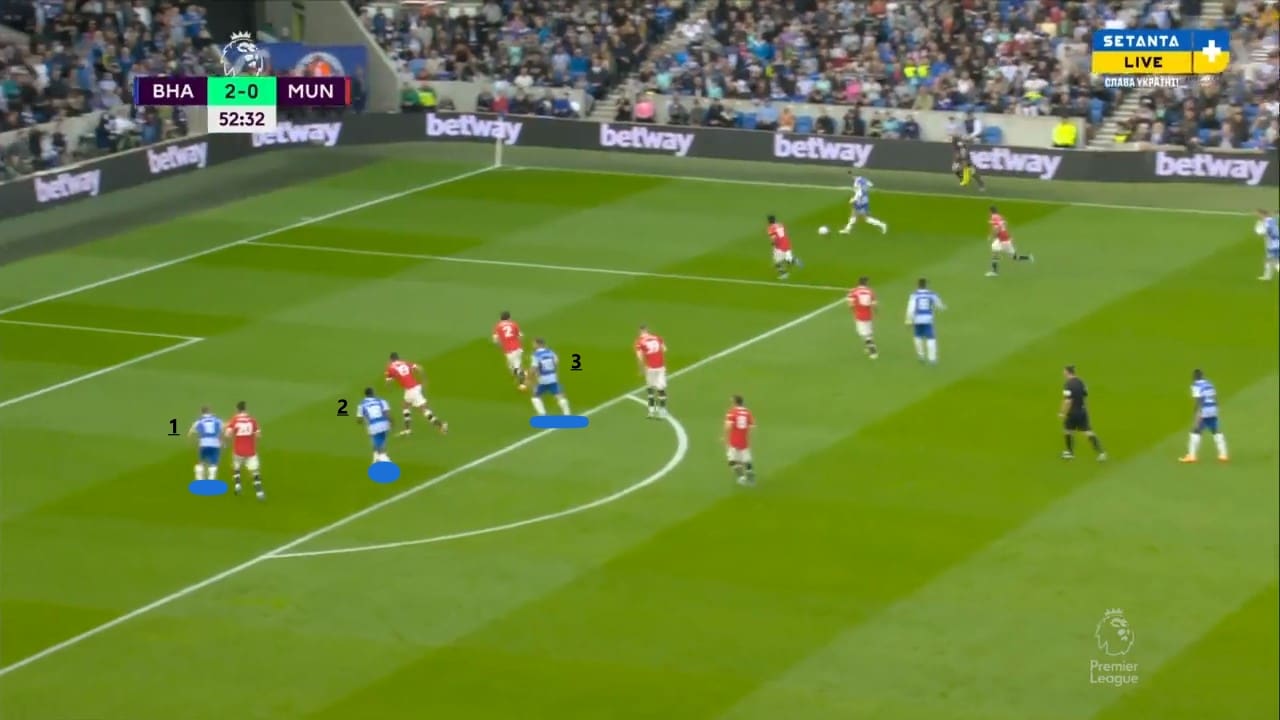
Graham Potter Tactics Out of Possession
Defensively Brighton and Hove Albion set up very rigid and stick to a 5-3-2 formation. This setup allows the Seagulls to create three solid lines for the opposition to break down, leading to a frustrating and difficult task of playing through the lines. In the 5-3-2 Brighton’s wingbacks drop deep to create a bank of five.
One forward player joins the striker to create a two and the other becomes a disciplined midfielder who looks to disrupt and block any passes into the forward players. Yves Bissouma averages just over five interceptions per 90 which is the highest of any Brighton midfield player. His ability to read the play and position himself is crucial for the way Brighton’s boss sets his team up.
The Seagulls often deploy their 5-3-2 as a midblock. By doing this they control the opposition and keep tight gaps between players. If the opposition receives the ball in the midfield then Brighton are quick to close down and force play away from the central area.
Graham Potter sets his side up to be difficult to beat. Something that Brighton are particularly good at is committing fouls at the right time. When a dangerous situation occurs, Potter’s men often look to give a foul away and allow players to recover and set up defensively.

In terms of pressing, Brighton are very relaxed and cautious. Pressing from the front is something they monitor throughout the game and choose the right moment to apply themselves. Below you can see that Potter sets his team up to be cautious against Wolves. Danny Welbeck does not press the Wolves defenders and Brighton set up to press the midfield. Pressing from the front usually occurs following a back pass from either a midfield player to a defender or the goalkeeper. The manager instructs his team to capitalise on the momentum of a backwards pass by pressing and pushing up as one unit. However, this press is usually light and is not sustained for very long.

Defending deeper Potter’s team overload the box defensively. The Seagulls on several occasions wanted to ensure they had numerical superiority when defending their box. The system used evolves the full defensive back five dropping deep into the box along with the two midfield players. The attacking members of the side take up space around the box and, ultimately, Potter wants his side to break quickly. By overloading the box Brighton and Hove Albion limit the chances of the opposition gaining possession in a dangerous area.
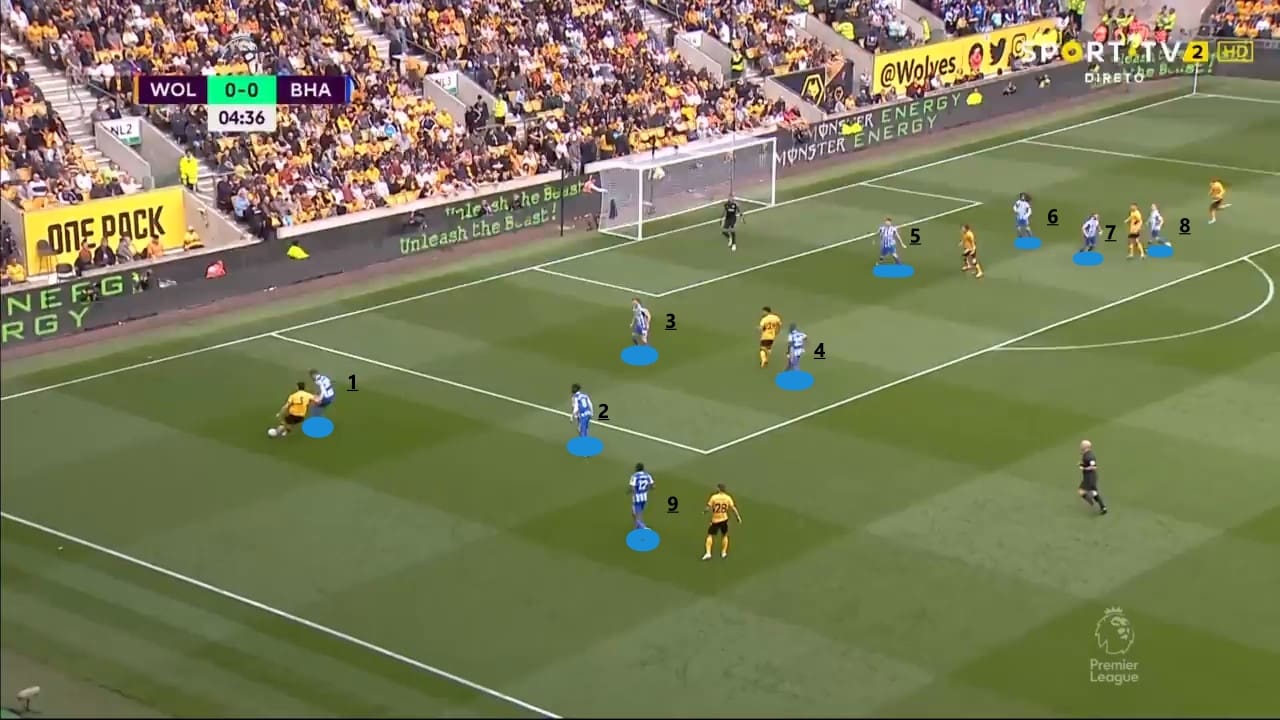
Graham Potter Defensive Transition
In terms of defensive transitions, Potter deploys a counter-press. The former Swansea boss wants his side to win the ball back as soon as possible. In comparison to other teams, Brighton’s counterpress is not as long-lived and is only maintained for a few seconds. The success rate of this is relatively high as Brighton are so aggressive in doing so. Possession retention or a foul given away is the most likely outcome and rarely do teams play through the initial counterpress.
Below you can see Potter’s team adopt an almost man for man approach following the loss of possession. The high risk, high reward nature of this system comes off more often than not and Brighton win the ball back high up the pitch. The side ranks fourth in the Premier League for challenge intensity, with 6.6, which measures duels, tackles and interceptions per minute of opponent possession.
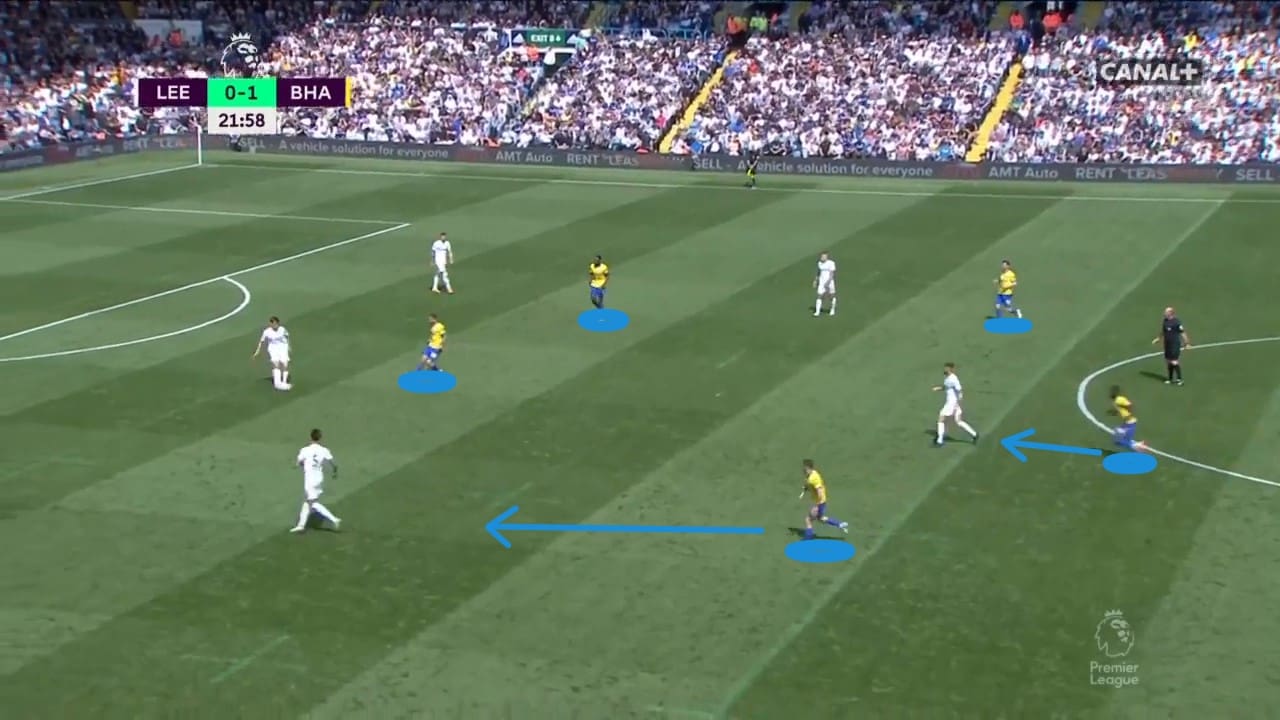
However, Potter’s side lacks defensive transition and it is sometimes inadequate and can leave them exposed. The lack of bodies centrally causes a big issue when it comes to transitioning back into their main defensive shape. If the counter-press is unsuccessful then Brighton leave themselves wide open in the central area. With only two central midfield players, it is easy for teams to bypass the Brighton midfield. This is something that Potter manages and it is a reflection of his playing style, open and expansive football.
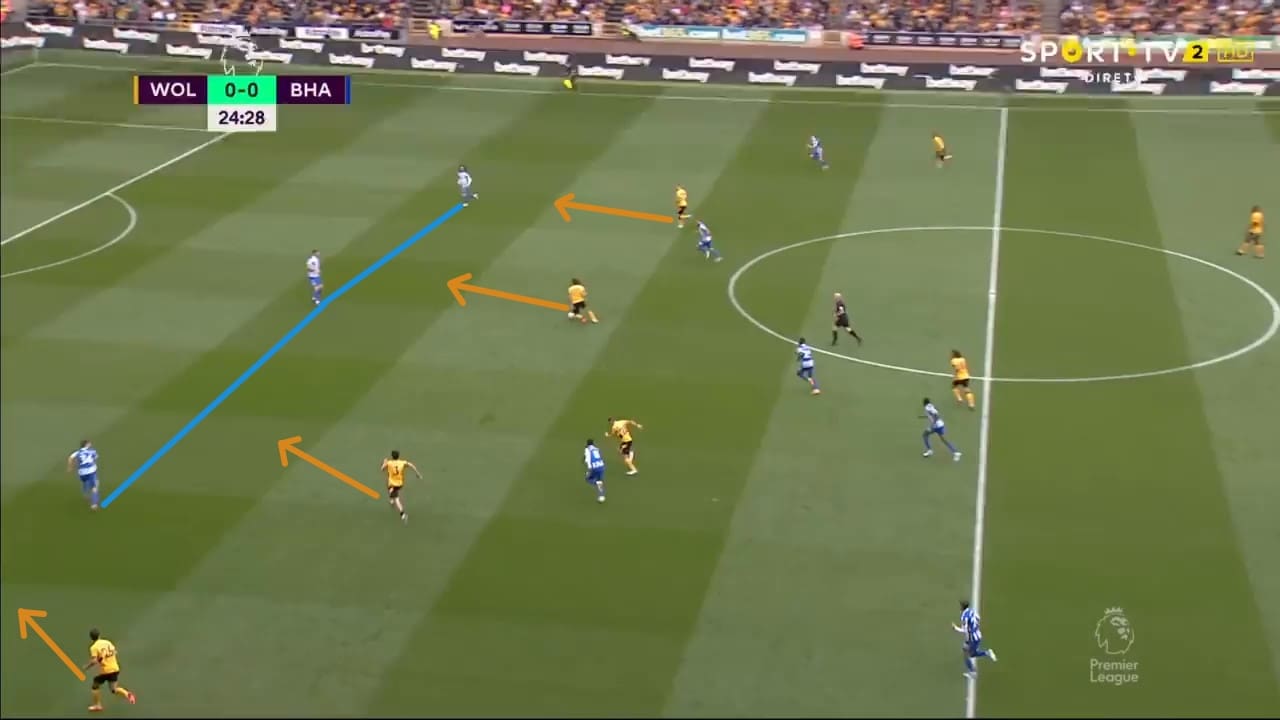
Graham Potter Attacking Transition
Brighton’s attacking transitions are fast and furious. They want to counterattack quickly and exploit the opposition’s unbalanced shape following a turnover in possession. The wingbacks very quickly break forward to support the attack. Also, the wide attacking players look to take up space centrally to link play with the striker and the wingbacks. Cucurella often joins the attack overlapping the left wing-back Leandro Trossard who likes to cut inside.
Their attacking transitions are important as they want to progress to the final third. Brighton and Hove Albion have the fifth most passes to the final third per 90 with 50.2 in the Premier League this season. Their attacking transition consists of a long ball out wide into the space which is then followed by a cross. Alternatively, Brighton look to build from the striker’s feet. Danny Welbeck on average receives 13 passes per 90 minutes playing as a solo striker. He is key during transitions as he is always the furthest forward and provides a solid target during the transition.
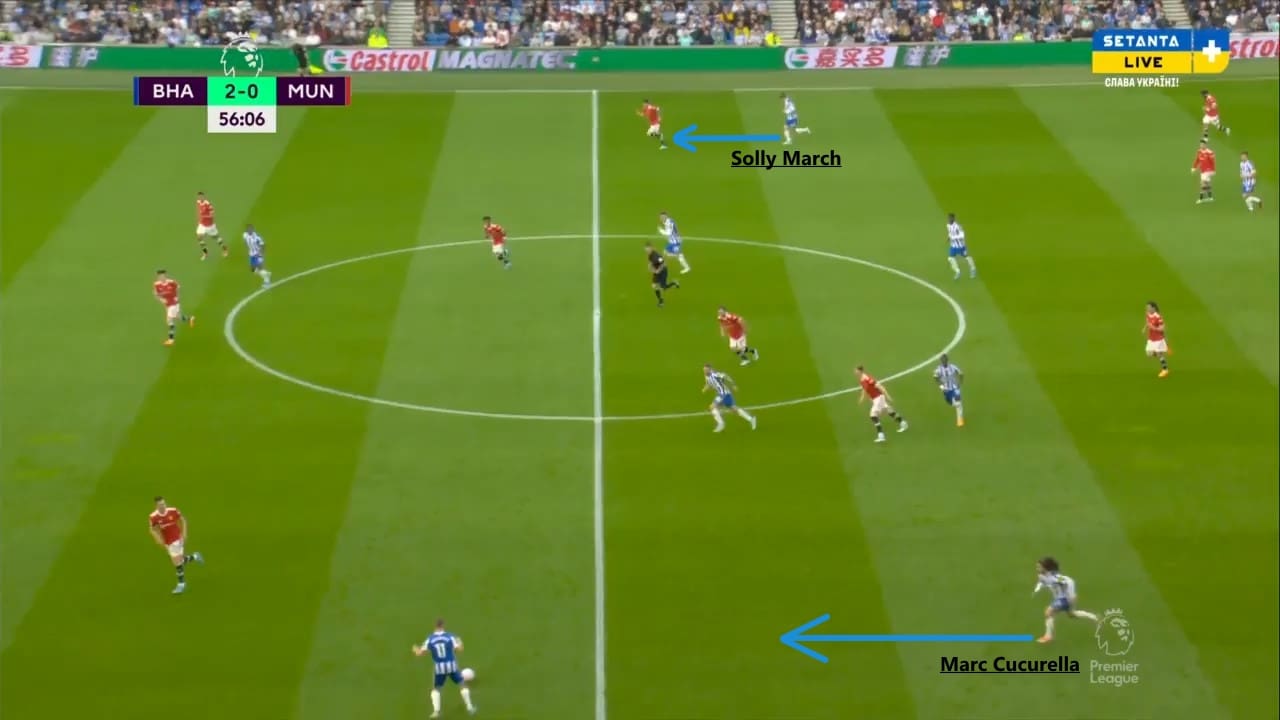
Conclusion
Overall, Graham Potter is likely to have a very successful managing career as the job he has done with Brighton is immense considering the budget and wage bill. Potter is a flexible and adaptable manager who caters for the strengths and weaknesses of the opposition whilst also having a defined way of playing. His side amassed the fourth-highest average possession per 90 this season with 54.8 percent. Only Manchester City, Liverpool and Chelsea averaged more. Potter has a clear ability to be able to dominate games but also win them. The recent thrashing of Manchester United proved that his side can be without the ball as Brighton only had 45 per cent possession and only created an xG of 2. Potter will again be linked with a move away from the Amex and it is only a matter of time before he leaves the South Coast for a ‘top 6’ club.





Comments